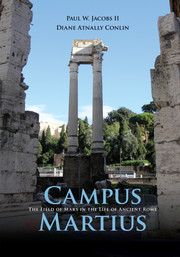Book contents
- Frontmatter
- Contents
- Illustrations
- Acknowledgments
- Maps
- Introduction: “This Place Was Holiest of All”
- Chapter One “The Size of the Plain Is Remarkable”: Defining the Limits of the Campus Martius in Time and Space
- Chapter Two Gathering Troops in the War God's Field
- Chapter Three “Very Costly Temples”: The Campus Martius and Republican Temple Construction
- Chapter Four “Chariot Races,” “Three Theatres,” “An Amphitheatre,” and More: Entertainment in the Campus Martius
- Chapter Five “Colonnades about It in Very Great Numbers”: The Porticoes of the Campus Martius
- Chapter Six Between the Aqua Virgo and the Tiber: Water and the Field of Mars
- Chapter Seven “A Zeal for Buildings”: Reshaping of the Space by the Emperors
- Conclusion: “The Rest of the City a Mere Accessory”
- Appendix A Chronology of Development in the Campus Martius to the Early Fourth Century c.e.
- Appendix B Glossary of Architectural Terms
- Notes
- Selected Bibliography
- Index
- Plate Section
Chapter One - “The Size of the Plain Is Remarkable”: Defining the Limits of the Campus Martius in Time and Space
Published online by Cambridge University Press: 18 December 2014
- Frontmatter
- Contents
- Illustrations
- Acknowledgments
- Maps
- Introduction: “This Place Was Holiest of All”
- Chapter One “The Size of the Plain Is Remarkable”: Defining the Limits of the Campus Martius in Time and Space
- Chapter Two Gathering Troops in the War God's Field
- Chapter Three “Very Costly Temples”: The Campus Martius and Republican Temple Construction
- Chapter Four “Chariot Races,” “Three Theatres,” “An Amphitheatre,” and More: Entertainment in the Campus Martius
- Chapter Five “Colonnades about It in Very Great Numbers”: The Porticoes of the Campus Martius
- Chapter Six Between the Aqua Virgo and the Tiber: Water and the Field of Mars
- Chapter Seven “A Zeal for Buildings”: Reshaping of the Space by the Emperors
- Conclusion: “The Rest of the City a Mere Accessory”
- Appendix A Chronology of Development in the Campus Martius to the Early Fourth Century c.e.
- Appendix B Glossary of Architectural Terms
- Notes
- Selected Bibliography
- Index
- Plate Section
Summary
Time
For many travelers to Rome today, the center of the city is often considered the area around the nineteenth-century monument to King Victor Emmanuel II, an imposing marble structure with a high colonnade that looks north over tightly spaced buildings and a busy traffic circle. Built hard up against the Capitoline Hill, a natural landscape feature known today as the Campidoglio, this memorial to the first king of a unified Italy hides from view the hill that once dominated the ancient skyline as seen from the northern reaches of the city. But wander off to the western side of the monument, and the visitor discovers the ramped carriage steps leading to the Campidoglio, the perfectly balanced space created by Michelangelo in the sixteenth century. From this high vantage point, the modern observer's gaze extends to the northern horizon across a plain dominated by tile-roofed structures from the seventeenth through nineteenth centuries. At the viewer's right is the very straight Via del Corso running north from the Piazza Venezia, but the undulating Tiber River on the left is now hidden by trees and a floodwall (Figure 1).
Three millennia ago the Capitoline was a very different place. As a result of lava flows from volcanic eruptions over the previous 600,000 years, nearly 100,000 square meters of hilltop formed a rugged saddle of tufa resting between two higher peaks. A small village of wooden huts sat on the relatively flat space between the rises, with similar villages dotting Rome's other hilltops. Instead of an urban landscape lying to the north of the Capitoline, there was a marshy plain punctuated by woods and shallow pools of water. Caught between the Tiber River to the west and the Pincian and Quirinal Hills to the east, the flatland became a lake for many days during the seasonal inundations from the river's floodwaters. Further north, where the Tiber curves close to the hills, a small volcanic fissure hinted at the region's seismic instability. A narrow stream, later known as the Petronia Amnis, wended from the Quirinal through the marsh before emptying into the Tiber (Plan 1). Few, if any, artificial features stood between the trees and wetland pools on the plain to suggest human encroachment. This, however, was the area that – many centuries later – Romans would know as the Campus Martius, the Field of Mars.
- Type
- Chapter
- Information
- Campus MartiusThe Field of Mars in the Life of Ancient Rome, pp. 7 - 19Publisher: Cambridge University PressPrint publication year: 2015



